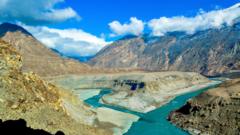India's recent suspension of the Indus Waters Treaty amidst escalating tensions with Pakistan has led to questions about the country's capacity to restrict river flows to its neighbor. While experts argue that significant infrastructure limitations hinder India's ability to effectively control water dynamics, the potential consequences of such actions during the dry season have raised alarms in Pakistan about future water security.
India's Water Management Strategy: Suspended Treaty Raises Environmental Concerns

India's Water Management Strategy: Suspended Treaty Raises Environmental Concerns
As India suspends the Indus Waters Treaty in response to recent tensions, experts debate the feasibility and implications of reallocating river flows to Pakistan.
In a significant development, India has suspended the Indus Waters Treaty (IWT)—a key agreement regulating water sharing of the Indus river system—sparking discussions on whether it can effectively halt the flow of river water into Pakistan. This decision follows an attack in Indian-administered Kashmir which has further strained relations between the two nuclear-armed neighbors. The IWT, signed in 1960, has long been a focal point of trans-boundary water management and survived two previous wars between India and Pakistan.
Reasons for India's decision largely stem from accusations against Pakistan of harboring terrorist activities, a claim Pakistan has vehemently rejected. While treaty stipulations allocate the eastern rivers—such as Ravi, Beas, and Sutlej—to India and confer around 80% control of the western rivers—Indus, Jhelum, and Chenab—to Pakistan, the recent suspension introduces unprecedented tensions.
Despite India's geographical advantage as an upstream country, experts suggest that halting the flow of the western rivers poses significant challenges. Infrastructure limitations make it nearly impossible for India to withhold vast amounts of water during high-flow seasons. Most of India's river management projects are run-of-the-river hydropower systems, which generate electricity without retaining large volumes of water for later use.
Calls for modifying the IWT have grown in India, prompted by changing national demands, including agricultural needs and climate change. However, despite India's push for infrastructure improvements, the construction pace of necessary projects remains sluggish. Still, experts note that if India attempts to control the flow of water, it could primarily impact Pakistan during drier months when water scarcity is more pronounced.
The treaty requires India to share vital hydrological data with Pakistan, essential for managing water resources and forecasting floods. Though this cooperation has been limited, India’s recent announcement implies it may cease sharing this information, further jeopardizing Pakistan's water management efforts.
A pressing concern remains the potential for "weaponizing" water. While immediate risks of flooding in India may arise if it were to withhold water, the legacy of Himalayan silting poses a significant threat; India could flush silt from its reservoirs, potentially causing downstream obstruction and damage in Pakistan.
This situation also mirrors broader tensions in the region, particularly as China has been enhancing its control over rivers that flow towards India. Past incidents have seen diplomatic rhetoric escalate around the themes of "blood and water" intertwining with geopolitical motivations, highlighting the precarious balance required in managing shared water resources in a climate of distrust.
As both nations navigate these turbulent waters, the Indus river remains more than just a geographic feature; it is a critical lifeline for millions, and any disruption carries the specter of broader humanitarian and ecological consequences.


















